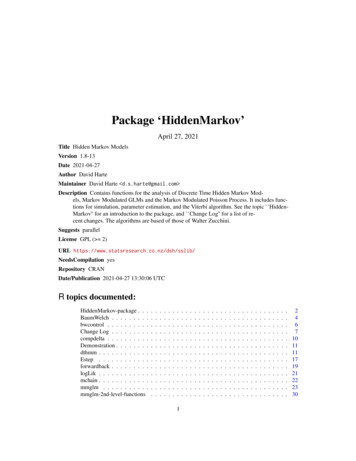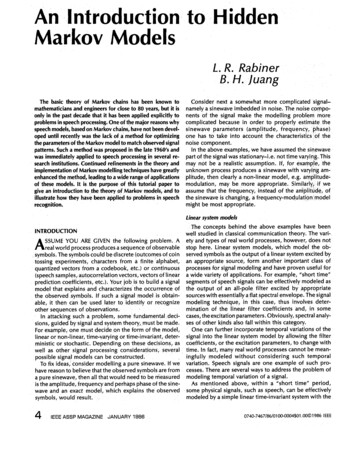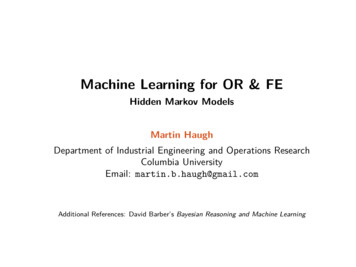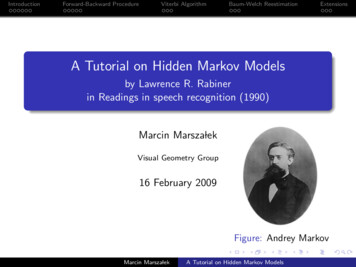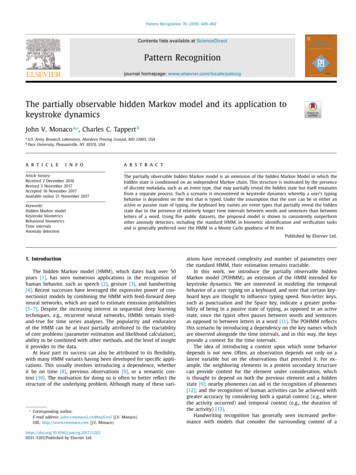
Transcription
Pattern Recognition 76 (2018) 449–462Contents lists available at ScienceDirectPattern Recognitionjournal homepage: www.elsevier.com/locate/patcogThe partially observable hidden Markov model and its application tokeystroke dynamicsJohn V. Monaco a, , Charles C. Tappert babU.S. Army Research Laboratory, Aberdeen Proving Ground, MD 21005, USAPace University, Pleasantville, NY 10570, USAa r t i c l ei n f oArticle history:Received 2 December 2016Revised 3 November 2017Accepted 16 November 2017Available online 21 November 2017Keywords:Hidden Markov modelKeystroke biometricsBehavioral biometricsTime intervalsAnomaly detectiona b s t r a c tThe partially observable hidden Markov model is an extension of the hidden Markov Model in which thehidden state is conditioned on an independent Markov chain. This structure is motivated by the presenceof discrete metadata, such as an event type, that may partially reveal the hidden state but itself emanatesfrom a separate process. Such a scenario is encountered in keystroke dynamics whereby a user’s typingbehavior is dependent on the text that is typed. Under the assumption that the user can be in either anactive or passive state of typing, the keyboard key names are event types that partially reveal the hiddenstate due to the presence of relatively longer time intervals between words and sentences than betweenletters of a word. Using five public datasets, the proposed model is shown to consistently outperformother anomaly detectors, including the standard HMM, in biometric identification and verification tasksand is generally preferred over the HMM in a Monte Carlo goodness of fit test.Published by Elsevier Ltd.1. IntroductionThe hidden Markov model (HMM), which dates back over 50years [1], has seen numerous applications in the recognition ofhuman behavior, such as speech [2], gesture [3], and handwriting[4]. Recent successes have leveraged the expressive power of connectionist models by combining the HMM with feed-forward deepneural networks, which are used to estimate emission probabilities[5–7]. Despite the increasing interest in sequential deep learningtechniques, e.g., recurrent neural networks, HMMs remain triedand-true for time series analyses. The popularity and enduranceof the HMM can be at least partially attributed to the tractabilityof core problems (parameter estimation and likelihood calculation),ability to be combined with other methods, and the level of insightit provides to the data.At least part its success can also be attributed to its flexibility,with many HMM variants having been developed for specific applications. This usually involves introducing a dependence, whetherit be on time [8], previous observations [9], or a semantic context [10]. The motivation for doing so is often to better reflect thestructure of the underlying problem. Although many of these vari- Corresponding author.E-mail address: john.v.monaco2.civ@mail.mil (J.V. Monaco).URL: http://www.vmonaco.com (J.V. 10031-3203/Published by Elsevier Ltd.ations have increased complexity and number of parameters overthe standard HMM, their estimation remains tractable.In this work, we introduce the partially observable hiddenMarkov model (POHMM), an extension of the HMM intended forkeystroke dynamics. We are interested in modeling the temporalbehavior of a user typing on a keyboard, and note that certain keyboard keys are thought to influence typing speed. Non-letter keys,such as punctuation and the Space key, indicate a greater probability of being in a passive state of typing, as opposed to an activestate, since the typist often pauses between words and sentencesas opposed to between letters in a word [11]. The POHMM reflectsthis scenario by introducing a dependency on the key names whichare observed alongside the time intervals, and in this way, the keysprovide a context for the time intervals.The idea of introducing a context upon which some behaviordepends is not new. Often, an observation depends not only on alatent variable but on the observations that preceded it. For example, the neighboring elements in a protein secondary structurecan provide context for the element under consideration, whichis thought to depend on both the previous element and a hiddenstate [9]; nearby phonemes can aid in the recognition of phonemes[12]; and the recognition of human activities can be achieved withgreater accuracy by considering both a spatial context (e.g., wherethe activity occurred) and temporal context (e.g., the duration ofthe activity) [13].Handwriting recognition has generally seen increased performance with models that consider the surrounding context of a
450J.V. Monaco, C.C. Tappert / Pattern Recognition 76 (2018) 449–462handwritten character. The rationale for such an approach is that acharacter may be written with different style or strokes dependingon its neighboring characters in the sequence. Under this assumption, the neighboring pixels or feature vectors of neighboring characters can provide additional context for the character under consideration. Alternatively, a separate model can be trained for eachcontext in which the character appears, e.g., “t” followed by “e”versus “t” followed by “h” [10]. This same principle motivates thedevelopment of the POHMM, with the difference being that thecontext is provided not by the observations themselves, but by aseparate sequence.We apply the POHMM to address the problems of useridentification, verification, and continuous verification, leveragingkeystroke dynamics as a behavioral biometric. Each of these problems requires estimating the POHMM parameters for each individual user. Identification is performed with the maximum a posteriori (MAP) approach, choosing the model with maximum a posterior probability; verification, a binary classification problem, isachieved by using the model log-likelihood as a biometric score;and continuous verification is achieved by accumulating the scoreswithin a sliding window over the sequence. Evaluated on five public datasets, the proposed model is shown to consistently outperform other leading anomaly detectors, including the standardHMM, in biometric identification and verification tasks and is generally preferred over the HMM in a Monte Carlo goodness of fittest.All of the core HMM problems remain tractable for the POHMM,including parameter estimation, hidden state prediction, and likelihood calculation. However, the dependency on event types introduces many more parameters to the POHMM than its HMM counterpart. Therefore, we address the problem of parameter smoothing, which acts as a kind of regularization and avoids overfitting [14]. In doing so, we derive explicit marginal distributions,with event type marginalized out, and demonstrate the equivalence between the marginalized POHMM and the standard HMM.The marginal distributions conveniently act as a kind of backoff, orfallback, mechanism in case of missing data, a technique rooted inlinguistics [15].The rest of this article is organized as follows. Section 2 brieflydescribes keystroke dynamics as a behavioral biometric.Section 3 introduces the POHMM, followed by a simulationstudy in Section 4 and a case study of the POHMM applied tokeystroke dynamics in Section 5. Section 6 reviews previousmodeling efforts for latent processes with partial observability andcontains a discussion. Finally, Section 7 concludes the article. ThePOHMM is implemented in the pohmm Python package and sourcecode is publicly available.12. Keystroke dynamicsKeystroke dynamics refers to the way a person types. Prominently, this includes the timings of key press and release events,where each keystroke is comprised of a press time tn and a duration dn . The time interval between key presses, τn tn tn 1 , isof interest. Compared to random time intervals (RTIs) in which auser presses only a single key [16], key press time intervals occurbetween different keys and are thought to be dependent on keydistance [11]. A user’s keystroke dynamics is also thought to berelatively unique to the user, which enable biometric applications,such as user identification and verification [17].As a behavioral biometric, keystroke dynamics enables low-costand non-intrusive user identification and verification. Keystrokedynamics-based verification can be deployed remotely, often as1Available at https://github.com/vmonaco/pohmm and through PyPI.a second factor to username-password verification. Some of thesame attributes that make keystroke dynamics attractive as a behavioral biometric also present privacy concerns [18], as there existnumerous methods of detecting keystrokes without running software on the victim’s computer. Recently, it has been demonstratedthat keystrokes can be detected through a wide range of modalities including motion [19], acoustics [20], network traffic [21], andeven WiFi signal distortion [22].Due to the keyboard being one of the primary human-computerinterfaces, it is also natural to consider keystroke dynamics as amodality for continuous verification in which a verification decisionis made upon each key pressed throughout a session [23]. Continuous verification holds the promise of greater security, as users areverified continuously throughout a session beyond the initial login,which is considered a form of static verification. Being a sequentialmodel, the POHMM is straightforward to use for continuous verification in addition to identification and static verification.Keystroke time intervals emanate from a combination of physiology (e.g., age, gender, and handedness [24]), motor behavior (e.g.,typing skill [11]), and higher-level cognitive processes [25], highlighting the difficulty in capturing a user’s typing behavior in asuccinct model. Typing behavior generally evolves over time, withhighly-practiced sequences able to be typed much quicker [26]. Inbiometrics, this is referred to as template aging. A user’s keystrokedynamics is also generally dependent on the typing task. For example, the time intervals observed during password entry are muchdifferent than those observed during email composition.3. Partially observable hidden Markov modelThe POHMM is intended for applications in which a sequenceof event types provides context for an observed sequence of timeintervals. This reasoning extends to activities other than keystrokedynamics, such as email, in which a user might be more likely totake an extended break after sending an email instead of receivingan email, and programming, in which a user may fix bugs quickerthan making feature additions. The events types form an independent Markov chain and are observed alongside the sequenceof time intervals. This is in contrast to HMM variants where theneighboring observations themselves provide a context, such asthe adjacent characters in a handwritten segment [10]. Instead, theevent types are independent of the dynamics of the model.With this structure, a distinction can be made between userbehavior and task: the time intervals comprise the behavior, andthe sequence of event types, (e.g., the keys pressed) comprise thetask. While the time intervals reflect how the user behaves, the sequence of events characterize what the user is doing. This distinction is appropriate for keystroke dynamics, in which the aim is tocapture typing behavior but not the text itself which may be moreappropriately modeled by linguistic analysis. Alternatively, in casethe user transcribes a sequence, such as in typing a password, thetask is clearly defined, i.e. the user is instructed to type a particularsequence of characters. The POHMM aims to capture the temporalbehavior, which depends on the task.3.1. DescriptionThe HMM is a finite-state model in which observed values attime t depend on an underlying latent process [2]. At the nth timestep tn , a feature vector xn is emitted and the system can be inany one of M hidden states, zn . Let xN1 be the sequence of observedemission vectors and z1N the sequence of hidden states, where N isthe total number of observations. The basic HMM is defined by therecurrence relation, P xn1 1 , z1n 1 P (xn1 , z1n )P (xn 1 zn 1 )P (zn 1 zn ) .(1)
J.V. Monaco, C.C. Tappert / Pattern Recognition 76 (2018) 449–462Fig. 1. Partially observable hidden Markov model structure. Observed values (emission and event type) are shown in gray, hidden values (system state) are shown inwhite.The POHMM is an extension of the HMM in which the hidden stateand emission depend on an observed independent Markov chain.Starting with the HMM axiom in Eq. (1), the POHMM is derivedthrough following assumptions:1. An independent Markov chain of event types is given, denotedby N.12. The emission xn 1 depends on event type n 1 in addition tozn 1 .3. The hidden state zn 1 depends on n and n 1 in addition tozn .Applying the above assumptions to the HMM axiom,the conditional emission probability P (xn 1 zn 1 ) becomesP (xn 1 zn 1 , n 1 ); the conditional hidden state probabilityP (zn 1 zn ) becomes P (zn 1 zn , n , n 1 ); and the recurrencerelation still holds. The complete POHMM axiom is given by theformula, P xn1 1 , z1n 1 P (xn1 , z1n )P (xn 1 zn 1 , n 1 )P (zn 1 zn , n , n 1 )(2)where n and n 1 are the observed event types at times tn andtn 1 . The POHMM structure is shown in Fig. 1.The event types come from a finite alphabet of size m. Thus,while the HMM has M hidden states, a POHMM with m eventtypes has M hidden states per event type, for a total of m Munique hidden states.The event type can be viewed as a partial indexing to a muchlarger state space. Each observed event type restricts the model toa particular subset of M hidden states with differing probabilitiesof being in each hidden state, hence the partial observability. ThePOHMM starting and emission probabilities can be viewed as anHMM for each event type, and the POHMM transition probabilitiesas an HMM for each pair of event types.To illustrate this concept, consider a POHMM with two hiddenstates and three event types, where 31 [b, a, c]. At each timestep, the observed event type limits the system to hidden statesthat have been conditioned on that event type, as demonstratedin Fig. 2. Beginning at time 1, given observed event type 1 b,the system must be in one of the hidden states {1b, 2b}. Eventtype 2 a observed at time 2 then restricts the possible transitions from {1b, 2b} to {1a, 2a}. Generally, given any event type, thePOHMM must be in one of M hidden states conditioned on thatevent type. Section 3.6 deals with situations where the event typeis missing or has not been previously observed in which case themarginal distributions (with the event type marginalized out) areused.451Fig. 2. POHMM event types index a much larger state space. In this example, thereare two hidden states and three event types. Given observed event type b at time1, the system must be in one of the hidden states {1b, 2b}. The a observed at thenext time step limits the possible transitions from {1b, 2b} to {1a, 2a}.The POHMM parameters are derived from the HMM. Model parameters include π [j ω], the probability of starting in state j givenevent type ω, and a[i, j ψ , ω], the probability of transitioning fromstate i to state j, given event types ψ and ω before and afterthe transition, respectively2 . Let f( · ; b[j ω]) be the emission distribution that depends on hidden state j and event type ω, whereb[j ω] parametrizes density function f( · ). The complete set of parameters is denoted by θ {π , a, b}, where a is the m2 M2 transition matrix. While the total number of parameters in the HMM isM M2 MK, where K is the number of free parameters in theemission distribution, the POHMM contains mM m2 M2 mMKparameters. After accounting for normalization constraints, the degrees of freedom (dof) is m(M 1 ) m2 M (M 1 ) mMK.Marginal distributions, in which the event type is marginalizedout, are also defined. Let π [j] and f( · ; b[j]) be the marginalizedstarting and emission probabilities, respectively. Similarly, the parameters a[i, j ω], a[i, j ψ ], and a[i, j] are defined as the transition probabilities after marginalizing out the first, second, and bothevent types, respectively. The POHMM marginal distributions are exactly equal to the corresponding HMM that ignores the event types.This ensures that the POHMM is no worse than the HMM in casethe event types provide little or no information as to the processbeing modeled. Computation of POHMM marginal distributions iscovered in Section 3.6 and simulation results demonstrating thisequivalence are in Section 4.It may seem that POHMM parameter estimation becomes intractable, as the number of possible transitions between hiddenstates increases by a factor of m2 over the HMM and all otherparameters by a factor of m. In fact, all of the algorithms used forthe POHMM are natural extensions of those used for the HMM: thePOHMM parameters and variables are adapted from the HMM byintroducing the dependence on event types, and parameter estimation and likelihood calculation follow the same basic derivations as those for the HMM. POHMM parameter estimation remains linearly bounded in the number of observations, similar tothe HMM, performed through a modification of the Baum–Welch(BW) algorithm. The convergence property of the modified BW algorithm is demonstrated analytically in Section 3.4 and empiricallyin Section 4. The rest of this section addresses the three mainproblems of the POHMM, taken analogously as the three mainproblems of the HMM:2When a transition is involved, i and ψ always refer to the hidden state andevent type, respectively, before the transition; j and ω refer to those after the transition.
452J.V. Monaco, C.C. Tappert / Pattern Recognition 76 (2018) 449–4621. Determine P (xN N1 , θ ), the likelihood of an emission sequence1given the model parameters and the observed event types.2. Determine z1N , the maximum likelihood sequence of hiddenstates, given the emissions xNand event types N.11N , θ ), the maximum likelihood3. Determine arg maxθ P (xN 11parameters θ for observed emission sequence xN, given the1event type sequence.The first and third problems are necessary for identifying andverifying users in biometric applications, while the second problem is useful for understanding user behavior. The rest of this section reviews the solutions to each of these problems and otheraspects of parameter estimation, including parameter initializationand smoothing.3.2. Model likelihoodSince we assume Nis given, it does not have a prior distri1bution. Therefore, we consider only the likelihood of an emissionsequence given the model parameters θ and the observed eventtype sequence N, denoted by P (xN N1 ),3 leaving the joint model11N ) as an item for future work.likelihood P (xN, 11In the HMM, P (xN1 ) can be computed efficiently by the forwardprocedure which defines a recurrence beginning at the start of thesequence. This procedure differs slightly for the POHMM due to thedependence on event types. Notably, the starting, transition, andemission parameters are all conditionedon the given event type. Let αn [zn , n ] P xn1 , zn n , i.e., the joint probability of emission subsequence xn1 and hidden state zn , given event type n .Then, by the POHMM axiom (Eq. (2)), α n [zn , n ] can be computedrecursively by the formula,αn 1 [zn 1 , n 1 ] P (xn 1 zn 1 , n 1 ) P (zn 1 zn , n , n 1 )αn [zn , n ](3)znα1 [z1 , 1 ] P (x1 z1 , 1 )P (z1 1 )π [ j ω ] P ( z 1 j 1 ω )(5)f (xn ; b[ j, ω] ) P (xn zn j, n ω )(6)a[i, j ψ , ω] P (zn 1 j zn i, n ψ , n 1 ω )(7)and α n [j, ω] is the sequence obtained after substituting the modelparameters. The model likelihood is easily computed upon termi MNnation, since P (xNj 1 αN [ j, ω ] where ω N .1 1 ) A modified backward procedure is similarlydefined through abackwards recurrence. Let βn [zn , n ] P xN z , n . Then undern 1 nthe POHMM axiom, P (xn 1 zn 1 , n 1 )zn 1 P (zn 1 zn , n , n 1 )βn 1 [zn 1 , n 1 ](8)βN [zN , N ] 1.33.3. Hidden state predictionThe maximum likelihood sequence of hidden states is efficientlycomputed using the event type-dependent forward and backwardvariables defined above. First, let the POHMM forward-backwardvariable γn [zn , n ] P zn n , xN, i.e., the posterior probability of1hidden state zn , given event type n and the emission sequencexN1 . Let γ n [j, ω ] be the estimate obtained using the model parameters, making the same substitutions as above. Then γ n [j, ω] isstraightforward to compute using the forward and backward variables, given byαn [ j ω]βn [ j ω]P (xN1 N1 )αn [ j ω]βn [ j ω] Mi 1 αn [i ω ]βn [i ω ]γn [ j, ω] (10)where ω n . The sequence of maximum likelihood hidden statesis taken as,zn arg max1 j M γn [ j, ω] .(11)Similar to α n [j ω] and β n [j ω], γ n [j, ω] can be stored in a N Mmatrix and takes O(M2 N) time to compute. This is due to the factthat the event types are not enumerated at each step; the dependency on the event type propagates all the way to the re-estimatedparameters, defined below.(4)where Eq. (4) provides the initial condition. The modified forwardalgorithm is obtained by substituting the model parameters intoEqs. (3) and (4), whereβn [zn , n ] where β n [j, ω] is the sequence obtained after making the samesubstitutions.Note that at each n, α n [j, ω] and β n [j, ω] need only be computed for the observed ω n , i.e., we don’t care about eventtypes ω n . Therefore, only the hidden states (and not the eventtypes) are enumerated in Eqs. (3) and (8) at each time step. Likethe HMM, the modified forward and backward algorithms havetime complexity O(M2 N) and can be stored in a N M matrix.(9)For brevity, the dependence on θ is implied, writing P (xN1 N1 , θ ) as P (xN1 N1 ).3.4. Parameter estimationParameter estimation is performed iteratively, updating thestarting, transition, and emission parameters using the currentmodel parameters and observed sequences. In each iteration ofthe modified Baum–Welch algorithm, summarized in Algorithm 1,Algorithm 1 Modified Baum–Welch for POHMM parameter estimation.1. InitializationChoose initial parameters θo and let θ θo.2. ExpectationNUse θ , xN1 , 1 tocompute αn [ j ω ], βn [ j ω ],γn [ j, ω ], ξn [i, j ψ , ω ].3. MaximizationUpdate θ using the re-estimation formulae (Eqs. 12, 14, 15) toget θ π , a , b .4. RegularizationCalculate marginal distributions and apply parameter smoothingformulae.5. Termination If ln P xN N1 , θ ln P xN1 N1 , θ ,stop; else let θ θ and1go to step 2.the model parameters are re-estimated using the POHMM forward,backward, and forward-backward variables. Parameters are set toinitial values before the first iteration, and convergence is reachedupon a loglikelihood increase of less than .
J.V. Monaco, C.C. Tappert / Pattern Recognition 76 (2018) 449–4623.4.1. Starting parametersUsing the modified forward-backward variable given byEq. (10), the re-estimated POHMM starting probabilities are obtained directly byπ [ j ω] γ1 [ j ω](12)where ω 1 and re-estimated parameters are denoted by a dot.Generally, it may not be possible to estimate π [ j ω] for many ωdue to there only being one 1 (or several 1 for multiple observation sequences). Parameter smoothing, introduced in Section 3.7,addresses this issue of missing and infrequent observations.3.4.2. Transition parametersIn contrast to the HMM, which has M2 transition probabilities,there are m2 M2 unique transitionprobabilities in the POHMM. Let ξn [zn , zn 1 n , n 1 ] P zn 1 zn , n , n 1 , xN1 , i.e., the probability of transitioning from state zn to zn 1 , given event types n and n 1 as well as the emission sequence. Substituting the forwardand backward variable estimates based on model parameters, thisbecomes ξ n [i, j ψ , ω], given byξn [i, j ψ , ω] αn [i, ω]a[i, j ψ , ω] f (xn 1 ; b[ j ω])βn [ j ω]. (13)P (xN1 N1 )for 1 n N 1, ψ n and ω n 1 . The updated transitionparameters are then calculated by N 1ξ ψ , ω]δ (ψ , n )δ (ω, n 1 )γ ψ ]δ (ψ , n )δ (ω, n 1 )n 1 n [i, j N 1n 1 n [ia [i, j ψ , ω] 3.4.4. Convergence propertiesThe modified Baum-Welch algorithm for POHMM parameter estimation (Algorithm 1) relies on the principles of expectation maximization (EM) and is guaranteed to converge to a local maximum. The re-estimation formula (Eqs. (12), (14), and (15)) are derived from inserting the model parameters from two successive iterations, θ and θ , into Baum’s auxiliary function, Q θ , θ , and maximizing Q θ , θ with respect to the updated parameters. Convergence properties are evaluated empirically in Section 4, andAppendix B contains a proof of convergence, which follows thatof the HMM.3.5. Parameter initializationParameter estimation begins with parameter initialization,which plays an important role in the BW algorithm and may ultimately determine the quality of the estimated model since EMguarantees only locally maximum likelihood estimates. This workuses an observation-based parameter initialization procedure thatensures reproducible parameter estimates, as opposed to randominitialization. The starting and transition probabilities are simplyinitialized asπ [ j ω ] 1Ma[i, j ψ , ω] (14)453(19)1M(20)where δ (ω, n ) 1 if ω n and 0 otherwise. Note thata [i, j ψ , ω] depends only on the transitions between event types ψand ω in N, i.e., where n ψ and n 1 ω, as the summand1in the numerator equals 0 otherwise. As a result, the updated transition probabilities can be computed in O(M2 N) time, the same asthe HMM, despite there being m2 M2 unique transitions.for all i, j, ψ , and ω. This reflects maximum entropy, i.e., uniformdistribution, in the absence of any starting or transition priors.Next, the emission distribution parameters are initialized. Thestrategy proposed here is to initialize parameters in such a waythat there is a correspondence between hidden states from twodifferent models. That is, for any two models with M 2, hiddenstate j 1 corresponds to the active state and j 2 correspondsto the passive state. Using a log-normal emission distribution, thisis accomplished by spreading the log-mean initial parameters. Let3.4.3. Emission parametersFor each hidden state and event type, the emission distributionparameters are re-estimated through the optimization problem,η[ω] b [ j ω] arg maxb BN γn [ j ω] ln f (xn ; b )δ (ω, n ) .(15)Closed-form expressions exist for a variety of emission distributions. In this work, we use the log-normal density for time intervals. The log-normal has previously been demonstrated as a strongcandidate for modeling keystroke time intervals, which resemble aheavy-tailed distribution [27]. The log-normal density is given byf ( x; η , ρ ) 1 (ln x η )exp 2ρ 2xρ 2 π2(16)where η and ρ are the log-mean and log-standard deviation, respectively. The emission parameter re-estimates are given byη [ j ω] Nγn [ j ω] ln τn δ (ω, n )n 1 γn [ j ω ]δ (ψ , n )n 1 N(17)andρ [ j ω] 2 Nn 1γn [ j ω](ln τn η j ω )2 δ (ω, n ) Nn 1 γn [ j ω ]δ (ψ , n )andρ 2 [ω] n 1 Nδ ( ω , n )δ ( ω , n )n 1 ln xn Nn 1 Nn 1(21)(ln xn η[ω] )2 δ (ω, n ) Nn 1 δ (ω , n )(22)be the observed log-mean and log-variance for event type ω. Themodel parameters are then initialized asη[ j ω] η[ω] 2h ( j 1 ) hM 1ρ [ω](23)andρ 2 [ j ω ] ρ 2 [ω ](24)for 1 j M, where h is a bandwidth parameter. Using h 2, initialstates are spread over the interval [η[ω] 2ρ [ω], η[ω] 2ρ [ω]],i.e., 2 log-standard deviations around the log-mean. This ensuresthat j 1 corresponds to the state with the smaller log-mean, i.e.,the active state.3.6. Marginal distributions(18)for hidden state j, given event type ω. Note that the estimates forη [ j ω] and ρ [ j ω] depend only on the elements of γ n [j ω] where n ω.When computing the likelihood of a novel sequence, it is possible that some event types were not encountered during parameterestimation. This situation arises when event types correspond tokey names of freely-typed text and novel key sequences are observed during testing. A fallback mechanism (sometimes referred
454J.V. Monaco, C.C. Tappert / Pattern Recognition 76 (2018) 449–462to as a “backoff” model) is typically employed to handle missingor sparse data, such as that used linguistics [15]. In order for thePOHMM to handle missing or novel event types during likelihoodcalculation, the marginal distributions are used. This creates a twolevel fallback hierarchy in which missing or novel event types fallback to the distribution in which the event type is marginalizedout.Note also that while we assume N1 is given (i.e., has no prior),the individual n do have a prior defined by their occurrence in N1 . It is this feature that enables the event type to be marginalized out to obtain the equivalent HMM. Let the probability of eventtype ω at time t1 be π [ω], and the probability of transitioningfrom event type ψ to ω be denoted by a[ψ , ω]. Both can be computed directly from the event type sequence N1 , which is assumedto be a first-order Markov chain. The marginal π [j] is the probability of starting in hidden state j in which the event type has beenmarginalized out, π [ j] π [ j ω]π [ω](25)ω where is the set of unique event types in N.1Marginal transition probabilities are also be defined. Let a[i,j ψ ] be the probability of transitioning from hidden state i to hidden state j, given event type ψ while in hidden state i. The secondevent type for hidden state j has been marginalized out. This probability is given by a[i, j ψ ] a[i, j ψ , ω]a[ψ , ω] .(26)ω The marginal probability a[i, j ω] is defined similarly by a[i, j ω] ψ a[i, j ψ , ω ]a[ψ , ω ] ψ a [ψ , ω ].(27)Finally, the marginal a[i, j] is the probability of transitioning from ito j,1 a[i, j] a[i, j ψ , ω]a[ψ , ω] .m(28)No denominator is needed in Eq. (26) since the normalizati
2. Keystroke dynamics Keystroke dynamics refers to the way a person types. Promi- nently, this includes the timings of key press and release events, where each keystroke is comprised of a press time t n and a du- ration d n. The time interval between key presses, τ n t n t 1 , is of interest. Compared to random time intervals (RTIs) in .


